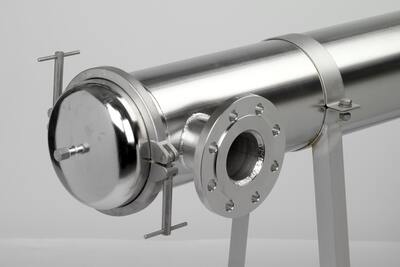
Water treatment in API production : What you need to know, outline & key points
Fine chemicals produce complex molecules from organic or mineral intermediates, the result of numerous chemical reactions in series. The corresponding industrial units generally operate on a batch basis. They involve a series of complex reactions with frequent operational changes (nature of solvents, pressure and temperature conditions, etc.). Filtration, in the broadest sense of the term, affects raw materials, intermediates and finished products, and is therefore an intrinsic part of the process.
One of the components of filtration in API production is utilities management. The generic term "utilities" refers, on the one hand, to the general resources required to operate an industrial plant, such as water, electricity, high- and low-pressure steam, gas, compressed air, etc., and, on the other hand, to all the facilities needed to produce them. So we need to be able to produce process water, rinse water, "clean" steam and "clean" gases (compressed air, nitrogen, etc.). Filtration plays an indispensable role in all these specific processes.

The European Pharmacopoeia distinguishes three levels of purification, depending on the application : Eau Purifiée (EP), Eau Hautement Purifiée (EHP), and Eau Pour Préparation Injectable (EPPI). These three purification levels are physically very similar, and correspond to a low level of conductivity. Their main difference is their increasing level of microbiological cleanliness.

Frontal or tangential filtration is used in all areas of the water treatment process, on raw water, at the outlet of carbon beds, to protect UV lamps, reverse osmosis membranes, final filtration before distribution, etc.
A distinction must be made between particulate filtration, whose aim is to eliminate insoluble particles still present in the water, and microbiological filtration, used to control biological loads (bacteria, endotoxins, etc.)
High water input requirements, combined with limited storage capacity, mean that flow rates can generally be relatively high (up to several tens of m³/h). In this case, for particle retention, which imposes fewer sanitary constraints on filter bodies, high-surface-area filter elements are increasingly preferred.
Typically, a filter cartridge of this range gives a surface area of 7 m² for a height of 40'' (and generally available up to 60''). As a reminder, a conventional cartridge of the same height is around 2 m².
In addition to facilitating maintenance operations (fewer filters to replace), one of the major points is the control of sizing and therefore an optimized footprint (an important issue when considering the need to limit the surface area of these production units as much as possible).
Filter elements must meet the requirements of texts on bacterial retention. This was specified by the FDA in "Guideline on Sterile Drug Products produced by Aseptic Processing", June 1987, which states : "Once a filtration process has been properly validated for a given process and filter, it is important to ensure that replacements of identical filters (membrane or cartridge) used in production cycles will function in exactly the same way.
One way to do this is to correlate filter performance data with filter integrity test data. Normally, the filter integrity test is carried out after assembly and sterilization of the filter unit, and before use. More importantly, these tests must be carried out after use to detect any leaks or degradation that may have occurred during filtration". To achieve this objective, it is necessary to prove the correlation between bacteria retention and a non-destructive integrity test.
 |
 |
Worth knowing:
Most manufacturers use the protocol based on the procedure documented in the chapter "Standard Test Method for Determining Bacterial Retention Of Membrane Filters Utilised For Liquid Filtration" (ASTM F838-83 supersedes HIMA Document No.3 Vol.4, April 1982, "Microbial Evaluation of Filters for Sterilising Liquids"). The bacterium conventionally used in this challenge is Brevundimonas Diminuta (Pseudomonas Diminuta) (ATCC19146) and the abatement must be at least 107 organisms/cm², or LRV (Log Reduction Value)^7.

Another challenge is to maintain the quality of the stored water. To achieve this, hydrophobic membranes are used. Either a 100% PTFE membrane, when integrity tests are scheduled during the life of the filter; or a PTFE-impregnated membrane (but in this case, no integrity test is possible).
Let's make no mistake: the performance of these two membranes with regard to the bacterial challenge is strictly identical. The same membranes validated for liquids are used. In fact, the efficiency is higher in the gas phase. This is due to the much greater Brownian motion of airborne particles compared with particles present in liquids.
Conclusion
Whatever the technical, industrial and commercial choices, it must be borne in mind that an API is the main component of a drug. As such, an API will act directly on our organisms.
Quality assurance is obviously provided by Good Manufacturing Practices (GMP) and all the international regulations (for the record, the pharmaceutical industry is the most subject of all to legally enforceable regulations). And yet, within this rigid framework, several approaches are possible in the management of filtration, or should we say filtrations.













